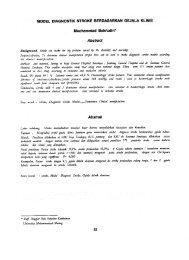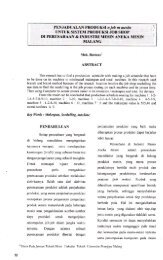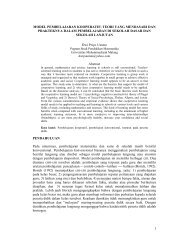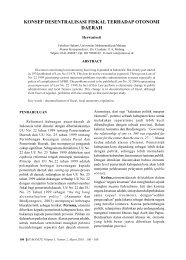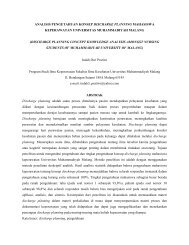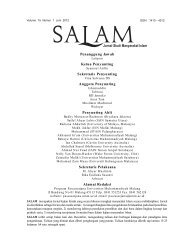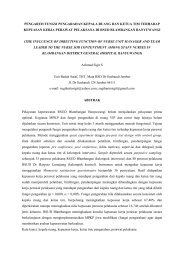Modeling Warehousing System to Improve Customer ...
Modeling Warehousing System to Improve Customer ...
Modeling Warehousing System to Improve Customer ...
Create successful ePaper yourself
Turn your PDF publications into a flip-book with our unique Google optimized e-Paper software.
eplenishment from central warehouse <strong>to</strong> remote<br />
warehouses, therefore the procurement quantities<br />
in this system are based on the separate order<br />
quantities of the different system s<strong>to</strong>cking of<br />
remote warehouse location or there will be a<br />
flexibility in replenishing the order <strong>to</strong> remote<br />
warehouses (retailers). This will sometimes affect<br />
the <strong>to</strong>tal inven<strong>to</strong>ry in both the remote warehouses<br />
and central warehouse where there will be a high<br />
risk for central warehouse <strong>to</strong> s<strong>to</strong>ck out and there<br />
will probably a longer lead time for the remote<br />
warehouses or retailers <strong>to</strong> receive their orders due<br />
<strong>to</strong> the central warehouse must cover all the remote<br />
warehouse order with different replenishment time.<br />
2.3 Warehouse and Inven<strong>to</strong>ry in 2 echelon<br />
One of the most important tasks of managing<br />
warehouse in a two echelon system is how <strong>to</strong><br />
decide <strong>to</strong> provide inven<strong>to</strong>ry in the system.<br />
Inven<strong>to</strong>ry carrying cost become substantial effect<br />
in the warehousing strategy implemented.<br />
Rosenfield and Pendrock (1986, 21) example on<br />
the self distribution network that the inven<strong>to</strong>ry<br />
carrying cost from the plant <strong>to</strong> the lower level of<br />
warehouses could be 2.5 percent of sales, a<br />
significant proportion. Two echelon warehousing<br />
system inven<strong>to</strong>ry flow from production facility or<br />
central warehouse where the central warehouse<br />
could be a consolidation of purchasing point or<br />
even as a part of production facility. The figure of<br />
how two echelon warehousing system flow the<br />
inven<strong>to</strong>ry is explained briefly from the figure 2.<br />
The inven<strong>to</strong>ries included the safety s<strong>to</strong>cks are<br />
located in each warehouse level <strong>to</strong> anticipate the<br />
variation of production lead time. The inven<strong>to</strong>ry<br />
occurs in warehouse when replenish its inven<strong>to</strong>ry<br />
from external source such as supplier or other<br />
production plants and there is also a holding cost<br />
counted per unit time inven<strong>to</strong>ry in remote<br />
warehouses or retailers (Teo and Shu, 2004, 397).<br />
2.4 Number of Warehouse<br />
In the centralized warehouse problem, the<br />
number of warehouse has a significant influence in<br />
the <strong>to</strong>tal inven<strong>to</strong>ry in all warehouses. If the number<br />
of warehouse increases, the local safety s<strong>to</strong>ck in<br />
each warehouse will decrease because the safety<br />
s<strong>to</strong>ck is distributed <strong>to</strong> more location. According <strong>to</strong><br />
Rosenfield and Pendrock (1986, 26), in this<br />
warehousing system, inven<strong>to</strong>ries in any<br />
warehouses consists of cycle s<strong>to</strong>cks and safety<br />
s<strong>to</strong>cks where the <strong>to</strong>tal cycle s<strong>to</strong>cks in whole system<br />
will not change when the number of warehouse<br />
increases because of the quantity of cycle s<strong>to</strong>cks in<br />
that specific warehouse is usually averaging in half a<br />
cycle time supply. That ensure the demand can be<br />
covered securely because of there is an extra s<strong>to</strong>ck<br />
when the supply received late (constant demand is<br />
assumed rarely occurred in the real world). The<br />
obvious result of this is probably the optimized<br />
cus<strong>to</strong>mer services by reducing the lost sales when<br />
there are a very high variations in cus<strong>to</strong>mer’s<br />
demands but there is still an extra inven<strong>to</strong>ry can be<br />
released <strong>to</strong> cover the unpredictable cus<strong>to</strong>mer’s<br />
demand.<br />
On the other hand, the increase number of<br />
warehouses in the pull system means that there are<br />
more cus<strong>to</strong>mers’ demand variations which affect the<br />
accuracy of order replenishment from central<br />
warehouse <strong>to</strong> retailers or remote warehouses. This<br />
probably impacts the level of s<strong>to</strong>cks in each retailer or<br />
remote warehouse in term of product availability. It is<br />
explained clearly by Coyle, Bardi and Langley (The<br />
Management of Business Logistic, 1992, pg. 60) in the<br />
figure (the trade-off between the number of<br />
warehouses and the cost of lost sale) that the more<br />
number of warehouses, the less cost of lost sale or we<br />
can say that the cus<strong>to</strong>mer service level will be good,<br />
however the more number of warehouses also reflect<br />
the more demand variations in each remote<br />
warehouses and retailers that means the central<br />
warehouse (plant) in the decentralized warehousing<br />
system will have a huge difficulties in covering all<br />
those warehouses’ fluctuated demand in different<br />
quantity (lot size), different lead time and different<br />
distances, or in other words that the probability of<br />
failure <strong>to</strong> replenish the product’s orders in this system<br />
is higher than the centralized warehousing policy.<br />
2.5 Sales Volume<br />
The decision of choosing the warehouse<br />
strategy whether centralization or decentralization<br />
also depend on the kind items sold if fast-selling items<br />
or slow-selling items. When the items sold are fast<br />
selling, the warehousing strategy which s<strong>to</strong>cks plenty<br />
of inven<strong>to</strong>ries such as centralized system; there is no<br />
influence in term of increasing the safety s<strong>to</strong>ck<br />
especially in the remote warehouses (Rosenfield and<br />
Pendrock, 1986, 28). This is happened because of the<br />
large s<strong>to</strong>cks which enter in<strong>to</strong> warehouses are balanced<br />
by the fast selling s<strong>to</strong>cks sold or we can say that the<br />
high turnover of in and out s<strong>to</strong>cks will not impact



